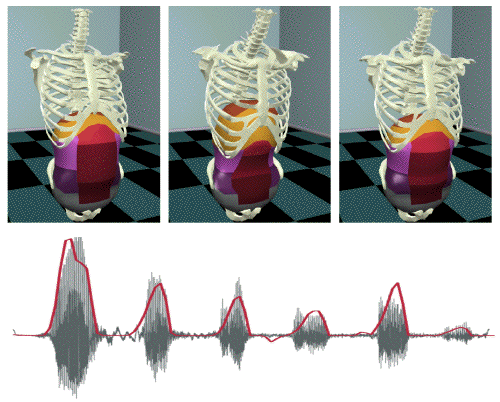|
|
BREATH SIMULATIONBreathing is a tell-tale sign of life in humans. Yet the gaming, movie, and graphics communities have not developed any general means for reproducing this motion realistically, instead relying on keyframing or stylized or simplified procedural versions of breath. In this work, we present an anatomically inspired, physically-based breathing simulation. We use one-way springs as a simple muscle element that drive the motion of rigid-body ribs and a deformable, volume conserving model to incorporate the motion of the abdomen moving in response to a simulated diaphragm. The abdomen's deformable body preserves its volume and is quasi-incompressible which approximates the motion of the gut. These two active systems, the ribs and the abdomen, create the core movement of breath following the biological functions which produce the motion in real humans. In the movies (and the paper), we provide more detail and show the flexibility of our system, including animation of several breathing styles. Breathe Easy: Model and Control of Human Respiration for Computer Animation Zordan, V. B., Celly, B., Chiu, B., Dilorenzo, P. C., ACM SIGGRAPH/Eurographics Symposium on Computer Animation, 2004 (29-38).  Movie 16M, 29M Movie 16M, 29MToward Anatomical Simulation for Breath Retraining in Mind/Body Medicine Sanders, B., DiLorenzo, P., Zordan, V., Bakal, D., Workshop on 3D Physiological Human. 2008. Press (UCR article) |
|
|
CONTROL FOR LAUGHINGWe present a novel technique for generating animation of laughter for a character. Our approach utilizes an anatomically inspired, physics-based model of a human torso that includes a mix of rigid-body and deformable components and is driven by Hill-type muscles. We propose a hierarchical control method which synthesizes laughter from a simple set of input signals. In addition, we present a method for automatically creating an animation from a soundtrack of an individual laughing. We show examples of laugh animations generated by hand-selected input parameters and by our audio-driven optimization approach. We also include results for other behaviors, such as coughing and a sneeze, created using the same model. These animations demonstrate the range of possible motions that can be generated using the proposed system. We compare our technique with both data-driven and procedural animations of laughter. |
 |
|
Laughing Out Loud: Control for Modeling Anatomically Inspired Laughter using Audio DiLorenzo, P., Zordan, V., Sanders, B., Transactions on Graphics/ACM SIGGRAPH Asia 2008 (to appear).  Movie 52M Movie 52M
|